Dr. Tao's Push Hands Workshop Videos
A master of Tai Chi push hands demonstrates the principles
Channel:
Essential Sports and Fitness Videos (Tai Chi)
This is the largest collection of videos on the web of Dr. Ping-Siang Tao in action, including two of his rare DVDs.
Although small and appearing frail, Dr. Tao was renowned for his mastery of push hands.
He was known as the "Master of the Soft Way".
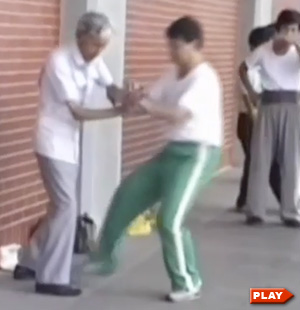
Push Hands Workshop Clip
Advanced practitioners try to push the good doctor. (00:04:48)
Dr. Tao's favorite method of teaching push hands was to allow students to try whatever they liked to push him
and demonstrate that there was always a soft way out.
As these videos show, he delighted in demonstrating that softness can overcome hardness.
He was consistent in attributing the amazing ease with which he
could defeat larger, stronger, and aggressive opponents, not to magic, but to applying basic principles of
physics: momentum, inertia, and leverage.
From: Dr. Ping-Siang Tao (DVD)
To watch clips of Dr. Tao's push hands, click on picture
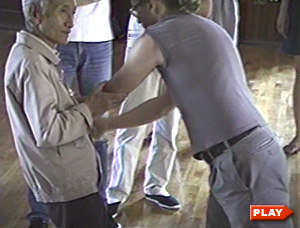
Push Hands Workshop 1
Protect yourself at all times but don't attack first. (00:12:37)
Dr. Tao explains and shows how "yielding while controlling" is the key to making push hands an effective martial arts
training exercise. He emphasizes proper positioning and control of joints, understanding the best defensive locations for
avoiding a direct attack, and letting your opponents ambition give you an opening.
From: Dr. Ping-Siang Tao (4 Postures DVD)
To watch clips of Dr. Tao's push hands, click on picture
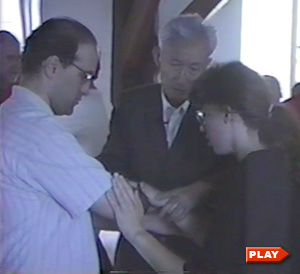
Push Hands Workshop 2
Yield. Don't let the bird land on your shoulder. (00:09:47)
Dr. Tao circulates through his class, correcting students as they push hands.
He encourages them to make themselves open and receptive, so that they can practice yielding.
He shows how to handle attacks by taking the opponent to one side or the other and by using the basic
push hands "postures".
From: Dr. Ping-Siang Tao (4 Postures DVD) (00:09:47)
To watch clips of Dr. Tao's push hands, click on picture
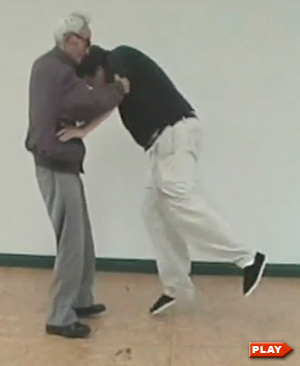
Push Hands Workshop 3
Unbalance your opponent without forcing it. (00:09:57)
Dr. Tao demonstrates taking the proper shapes to make it easy to yield and protect from
unexpected attacks, for example, to your thumb or by an attempted kick.
Through sensing an opponent's intentions, he shows that pushing or pulling an opponent off
balance can be done gently, with minimal force.
He reiterates the importance and difficulty of yielding, which requires giving up the ego and
understanding that "peace" is the true objective.
From: Dr. Ping-Siang Tao (4 Postures DVD)
To watch clips of Dr. Tao's push hands, click on picture
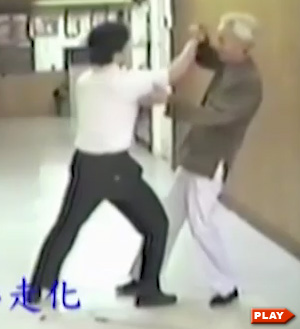
Basic Push Hands Lesson
Fundamentals of Tai Chi Chuan push hands. (00:10:59)
Dr. Tao reviews 4 basic moves: ward off, rollback, press, and push. He points out the importance of
yielding and the power generated by coordinated, whole-body movement.
This video was made with Sifu Howard Lee
in 1988 at William C. C. Chen's Tai Chi school in New York City.
From: Dr. Ping-Siang Tao (DVD)
To watch Dr. Tao's push hands lesson, click on picture
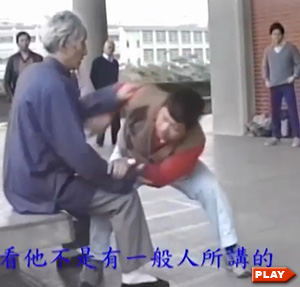
Public Push Hands Demonstrations
Push Hands from a sitting position and against groups of challengers. (00:06:47)
Dr. Tao put on demonstrations with his students that included pushing from a sitting position and pushing against
multiple opponents.
While this form of showbiz sometimes included some extra pushing distance
for dramatic effect, the attacks against him were never planned or rehearsed. (Editor's note: In the
many times
we pushed, I and the other students always tried hard to trap him, trick him, or shove him,
to no avail.)
From: Ping-Siang Tao (DVD)
To watch clips of Dr. Tao's push hands demos, click on picture
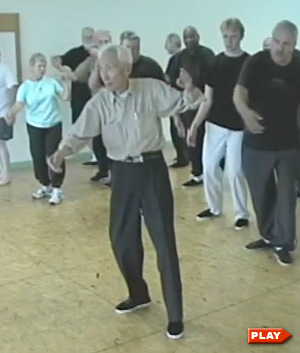
Push Hands Warm Up Exercises
Relaxed exercises in yielding in any direction. (00:07:32)
Dr. Tao started his push hands classes with a series of exercises in soft yielding, many of which have direct
application to push hands and martial arts.
In this video, he shows an example of using one of his dance-like moves to simultaneously neutralize an attack
and respond with a strike.
From: Dr. Ping-Siang Tao (4 Postures DVD)
To watch clips of Dr. Tao's push hands, click on picture
Dr. Tao on qi (chi) and the origins of power
|
Q: If we don't use force to practice the form, where does power come from?
A: We all know that our body weight is created by gravity. When we move any
part of our body, we will create what is called momentum and inertia. This
is naturally related to what is called potential energy.
...
Even though most people who practice Taiji Quan think a lot about qi, it is
important to understand that "qi" can refer to many things. It can refer to
primordial energy, to true energy, to vital energy, the energy of breath, and so
on. But there is one kind of qi that we call momentum qi: though it may seem
mysterious, it is involved in all our daily activities. ... When we are just beginning
to study ... we focus on particulars, like whether our posture is correct.
At that stage, we focus on things like breathing qi, or qi in the Dantien.
I tried to cultivate qi from meditation and qigong: I didn't understand that those
sorts of qi are irrelevant to momentum qi. ...
Q: Could you say something more about momentum qi and where it comes from?
A: Let me tell you a story. In 1950 I started to study with Cheng Man-Ching.
Later, I started living in his household, and had more time to study from him.
I had many tasks to do, but when I wasn't doing anything else, I would sit and meditate.
Once my teacher asked me what I was doing. I said that I was trying to cultivate qi.
"What qi" he asked. "The qi I need for Taiji Quan," I answered. At that he just smiled
and said, "You haven't even got your postures correct: how can you have any qi?"
...
I didn't know what he meant, and I spent days trying to come up with an answer.
When I really thought about his remark, I realized that there must be some sort of qi that
is initiated through movement. Later, I realized that the qi that arises in motion is
very similar to what is called momentum in dynamics. I also realized that, linked with
momentum, there is also inertia. that means that when you practice Taiji Quan to the
point that all sections of your body are threaded together and move as a unit, that
all the force threading through the different segments will merge, and become a huge
volume of energy. If there are blockages, if the threading together is not complete,
and loose, then different parts of your structure will interfere with the transmission
of the force, and the force will end up opposing itself. The key is to have no
obstructions, no resistances, so that force flows freely; to unify and synchronize
all components.
From "Taiji Push Hands - The Secret of Qi in Taiji Quan". By Ping-Siang Tao.
|
|
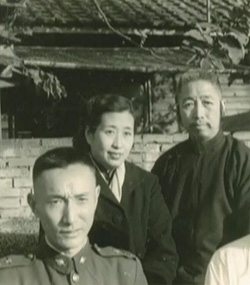
Dr. Tao with Cheng Man-Ching & wife
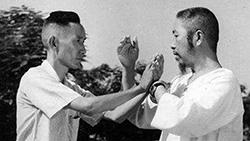
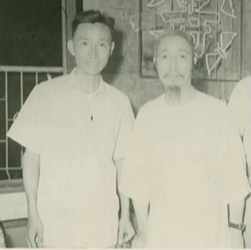
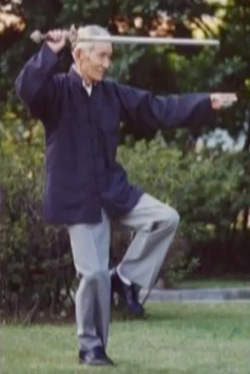
|